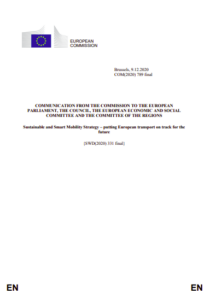The European Commission presented Wednesday its ‘Sustainable and Smart Mobility Strategy’, laying the foundation for a green and digital transformation in transport sector to make it more resilient to future crises. The strategy comes together with an Action Plan of 82 initiatives that will guide EU work for the next four years.
In line with the European Green Deal, the result will be a 90% cut in emissions by 2050, delivered by a smart, competitive, safe, accessible and affordable transport system.
To reach our climate targets, emissions from the transport sector must get on a clear downward trend. Today’s strategy will shift the way people and goods move across Europe and make it easy to combine different modes of transport in a single journey. We’ve set ambitious targets for the entire transport system to ensure a sustainable, smart, and resilient return from the COVID-19 crisis,
…said Frans Timmermans, Executive Vice-President for the European Green Deal.
Under the strategy, all transport modes need to become more sustainable, with green alternatives widely available and the right incentives put in place to drive the transition.
Among the several milestones to be achieved in the next decades is zero-emission marine vessels to be market-ready by 2030, while a fully operational, multimodal Trans-European Transport Network (TEN-T) for sustainable and smart transport with high speed connectivity will be ready by 2050.
To make these goals a reality, the strategy identifies a total of 82 initiatives in 10 key areas for action (“flagships”), each with concrete measures to make transport more sustainable, smart and resilient.
For maritime transport to become sustainable, in practice this means boosting the uptake of zero-emission vehicles, vessels and aeroplanes, renewable & low-carbon fuels and related infrastructure – for instance by installing 3 million public charging points by 2030.
In addition, it means creating zero-emission airports and ports – for instance through new initiatives to promote sustainable aviation and maritime fuels, and pricing carbon and providing better incentives for users – for instance by pursuing a comprehensive set of measures to deliver fair and efficient pricing across all transport.
Meanwhile, innovation and digitalization will shape how passengers and freight move around in the future if the right conditions are put in place. The strategy foresees:
- Making connected and automated multimodal mobility a reality – for instance by making it possible for passengers to buy tickets for multimodal journeys and freight to seamlessly switch between transport modes.
- Boosting innovation and the use of data and artificial intelligence (AI) for smarter mobility – for instance by fully supporting the deployment of drones and unmanned aircraft and further actions to build a European Common Mobility Data Space.
As transport has been one of the sectors hit hardest by the COVID-19 pandemic, and many businesses in the sector are seeing immense operational and financial difficulties. The Commission therefore commits to:
- Reinforce the Single Market – for instance through reinforcing efforts and investments to complete the Trans-European Transport Network (TEN-T) by 2030 and support the sector to build back better through increased investments, both public and private, in the modernization of fleets in all modes.
- Make mobility fair and just for all – for instance by making the new mobility affordable and accessible in all regions and for all passengers including those with reduced mobility and making the sector more attractive for workers.
- Step up transport safety and security across all modes – including by bringing the death toll close to zero by 2050.
Responding to the strategy, the European Transport Workers’ Federation, representing 5 million workers across all modes of transport, reiterated that, to fulfil the goals of the Strategy and enable the transition to greener transport, it is essential to address social issues and foster worker engagement.
Explore more on the strategy herebelow:































































